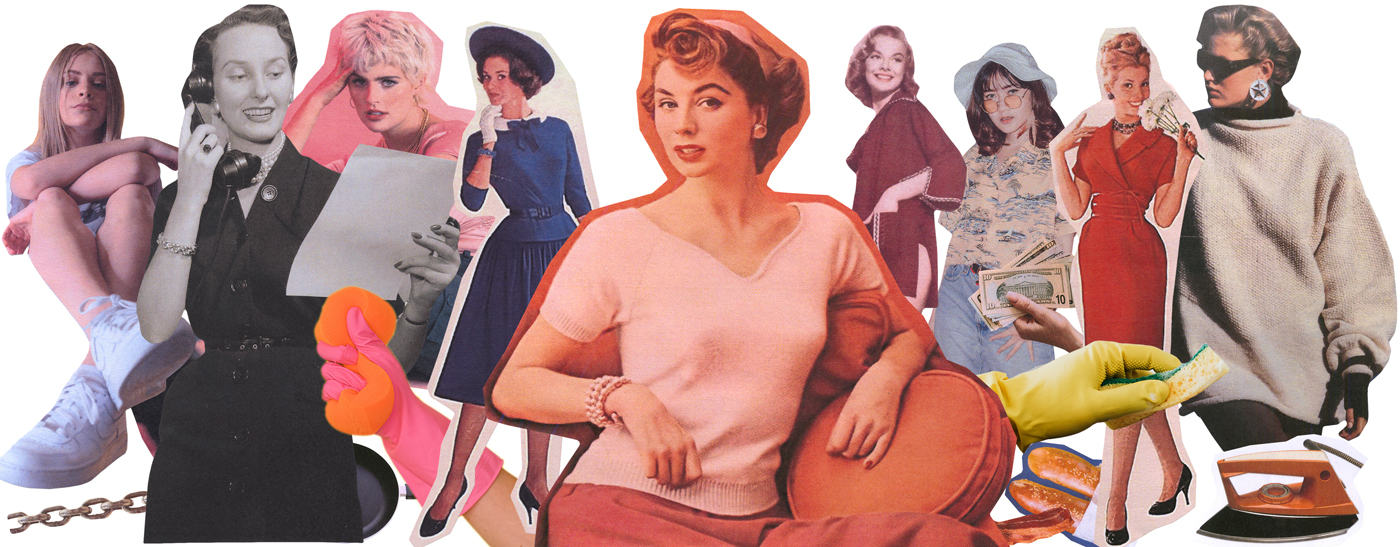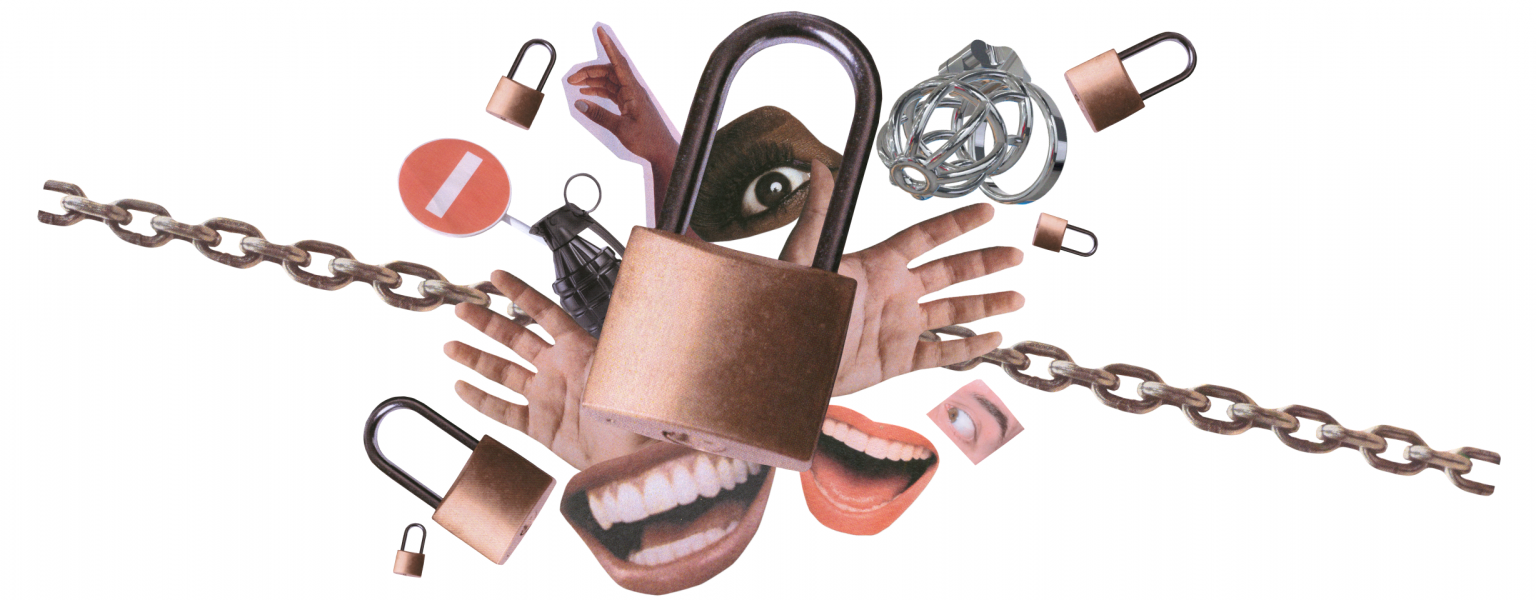
BDSM BOOKS
These are some of the most popular and trusted books written by reputable BDSM educators. You’ll find a little bit of everything on our list – BDSM 101, bondage instruction, D/s dynamics, kink community, communication skills, and more.
By Cathy Reisenwitz

A few months ago I was thinking about a vintage ad that showed a besuited husband administering a spanking to his high-heeled, 50’s housedress-clad wife. Bent over his knee, she didn’t look exactly horrified. It reminded me of so-called Gen Z tradwives. It’s funny how the ad so closely resembles what kinksters do on a regular basis. And it reminded me of the differences between 1950s female oppression and sex-positive feminist BDSM.
As thinkpiece writers have endlessly covered, hundreds of young women on social media are eschewing feminism to advocate for what they describe as more traditional gender roles. What if tradwives knew they could bake their cake (from scratch, in a frilly apron, while simultaneously making their husband’s favorite casserole for dinner) and eat it too? Perhaps the existence of tradwives can be less a repudiation of feminism and more an opportunity to fully embrace the best that feminism has to offer.
A tradwife (traditional wife) is a woman who adheres to ultra-traditional gender roles in marriage. This typically includes domestic tasks, prioritizing her husband’s career & submitting to male leadership. Beyond describing a lifestyle choice based on 1950s-era family values, the term tradwife has been embraced by and used in reference to a growing movement & subculture within far-right extremist communities.
It’s certainly true that many women long for a bygone era of male breadwinners and female homemakers. It makes sense that this message resonates so strongly among today’s young women.
Gen Z is entering a job market still impacted by two back-to-back recessions as well as rising inflation on top of years of stagnant wages. Basing your life’s meaning and purpose around paid work? In this economy? It’s not shocking that many young women aren’t excited about being expected to work full-time while also spending more hours on domestic labor than their spouses while also making less money than their male peers.
“Gen Z girls have watched their working mothers lean into unequal workplaces only to earn less money in a capitalist system that also devalues their domestic workload,” wrote Mariel Cooksey for Political Research Associates. My mother fought for “gender equality” and all I got was stress and fatigue.
There’s nothing wrong with yearning to raise kids, bake bread, and keep a tidy home while your husband brings home the bacon.
However, tradwife imagery around the 1950s housewife tends to ignore that “traditional” gender labor division was only available for a relatively brief period in American history and largely only for middle and upper-class white women. It also ignores the very real consequences of a legal system and society where women aren’t full citizens. It’s easy to yearn for an imaginary past when you forget that until recently marital rape was legal, many women couldn’t get a credit card without a male co-signer, and wives had terrible difficulty escaping rampant domestic violence. Choosing to financially depend on a man is one thing. A legal system set up to force you into dependence is quite another.
At best, modern tradwives incorporate overt or covert Christian and/or nationalist themes which exclude wannabe homemakers who happen to be queer and/or BIPOC. At worst, many tradwife accounts share explicitly racist and misogynistic messaging and/or host-friendly interactions with white supremacist accounts. Many thinkers suspect the tradwife trend sometimes acts as an unfortunate gateway to white supremacy and point to the historical links between white nationalism and white female submission as a societal ideal.
There are thousands of tradwife accounts, and at least a few hundred seem to have tens of thousands of followers. But is this just an online subculture, or does it speak to something more widespread?
In many ways, Gen Z is more progressive than previous generations. They’re more likely to identify as queer or gender non-conforming, for instance. Gen Z women on the whole are much more likely than Millennials or Gen X to identify as feminist.
But on sex and gender, some data complicates this picture. Almost a third of women 18-29 reject the “feminist” label. And feminist identification is only slightly up for Gen Z over the Boomer generation. Gen Z is also famously having less sex than previous generations.
Among 18-34 year-olds, support for gay marriage fell slightly between 2016 and 2020. And while it grew by 8 or 15 points among older generations between 2016 and 2022, it rose by just two points among the youngest cohort. Among religiously-affiliated Black Americans, Gen Z is significantly less likely than every older generation to agree that opposing sexism is essential to their faith. And 22% of adults under 30 oppose premarital sex as morally wrong.

Feminism is as fractured and contentious as any movement, perhaps even more than most. Just ask any sex-positive feminist, radical feminist, sex-critical feminist, sex-worker exclusionary radical feminist (SWERFs), trans-exclusionary radical feminist (TERF), white feminist, intersectional feminist, anti-carceral feminist, pro-choice feminist – and the list goes on.
Tradwives have correctly identified the shortcomings of pro-capitalist girlboss feminism and sex-negative feminism.
They’re absolutely right that any feminism which only seeks to help (white, well-educated, white-collar) women succeed in their careers is total shit. Intersectional feminism exists to acknowledge the problems with white feminism and do a better job dismantling oppressive systems like racism, classism, and rapacious capitalism along with sexism.
And they’re absolutely right that any feminism that shames women for wanting male breadwinners or female submission is also shit. Many feminists deride “traditional” gender roles as inherently and universally patriarchal. Sex-positive feminism exists to affirm that it’s not for me to tell consenting adults how to fuck, marry, or run their household.
Consensual power exchange is sexy as hell. There’s a reason BDSM is one of Americans’ top three most popular categories of sexual fantasies. For a quarter of Americans, it’s their favorite category of sexual fantasy. Fewer than 10% of Americans have never had a BDSM-themed fantasy.
When you think about it, tradwifery is kinky as hell too.
Today, most wives work outside the home, and many work full-time. A growing number of wives are out-earning their husbands. Tradwives, by contrast, depend on their husbands’ income. What differentiates a tradwife from a regular wife, beyond the aesthetics, is the wife’s voluntary choice to depend on her husband. This is a form of power exchange, the same concept which forms the basis of BDSM dynamics.
Tradwives tend to follow the exhortation for “wives, submit to your husbands” or the marital vow for women to “love, honor, and obey” their husbands. These are the fundamental concepts behind adult, consensual kinky sex. A tradwife and her husband are in what closely resembles a Dominant/submissive relationship in BDSM.
Even the aesthetics are kinky, as anyone with a 1950s housewife fetish can attest. Tradwifery often involves acting out many things that can also be considered kinks like domestic service-oriented submission, a 24/7 total power exchange/authority transfer, and a Leader/follower relationship. Some tradwives may even engage in physical bondage, have strict rules, or possibly even punishments.
There is one key difference between the kinky and tradwife versions of these activities, however – consent and how it is, or isn’t, prioritized.



I’d ask tradwives to reconsider their wholesale rejection of feminism as a category. Sexism is still rampant in our society, sometimes perpetrated by feminists. It is fundamentally sexist to tell a woman she’s wrong for wanting to enter into a consensual power exchange with a man due to their gender. It’s fundamentally impoverished to tell women to girlboss harder within rapacious capitalism.
Instead, I urge tradwives to consider sex and kink-positive, intersectional feminism. We share your critiques of the modern workplace, gendered expectations, and narrow-minded moralizing around sex.
Tradwife culture too often tries to whitewash a 1950s ideal that never really existed. In real life, gender-based oppression isn’t sexy. But consensually play-acting it can be.
Kink offers every benefit of tradwifery, but with the improvement of being safe, negotiated, and consensual. Rather than trapping women in lifelong dependence, reframing tradwifery as a kink leaves room for either party to re-negotiate or opt-out at any time, whether for a few hours or forever. In a kink scene, your husband can bend you over his knee when you make the coffee wrong, and you can still be the best kind of feminist. Many assume that if a woman is submissive in consensual BDSM they can’t be feminist … not true … it’s the consent, intent & ability to opt out of anything they’d like at any time that makes kink feminist AF
Kink and sex-positive feminism gives all people, regardless of gender, race, creed, etc. the freedom to live their lives as they see fit. It celebrates people being as kinky as they want to be. And if that means submitting to your husband, then go on with your bad self.
Tradwife culture too often tries to whitewash a 1950s ideal that never really existed. In real life, gender-based oppression isn’t sexy. But consensually play-acting it can be.
Sharing is caring

Cathy Reisenwitz
Cathy Reisenwitz writes the bestselling Sex and the State newsletter on Substack and is a top 12% creator on OnlyFans. Her bylines include TechCrunch, OneZero, VICE, Bitch Magazine, and the Daily Beast.

These are some of the most popular and trusted books written by reputable BDSM educators. You’ll find a little bit of everything on our list – BDSM 101, bondage instruction, D/s dynamics, kink community, communication skills, and more.

This month Fetish Con made its long-awaited in-person return after a two-year pandemic-related pause. We were there along with Clips4Sale to celebrate the 20th Anniversary of this legendary fetish event and to surprise attendees with our first print issue of Zipper Magazine.

We tend to associate safewords with BDSM, but did you know they can be used in other contexts too? Sunny Megatron breaks down what safe words are, what they aren’t, how they can be used in kink for ill intent, and how to customize them to fit your sexual (and sometimes non-sexual) needs.

In BDSM October is known as Locktober – a month of orgasmic restraint traditionally geared toward chastity subs and keyholders. It’s the perfect time to explore other orgasm control games too. These techniques can be long or short-term and enjoyed by anyone regardless of body type, budget, or partner status.